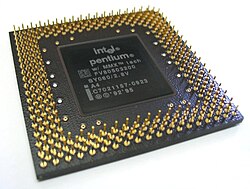cs:Intel Pentium pl:Pentium de:Pentium fr:Pentium nl:Pentium (processor) en:Pentium
The Pentium is a fifth-generation x86 architecture microprocessor by Intel which first shipped on March 22, 1993. É o sucessor da linha de processadores 486.Originalmente recebeu o nome 80586 ou i586, mas o nome mudou para Pentium pois os números não podiam ser registrados.
Principais mudanças em relação ao 486:
- Superscalar architecture - The Pentium has two datapaths that allow it to complete more than one instruction per clock cycle. One pipe (called "U") can handle any instruction, while the other (called "V") can handle the simplest, most common instructions.
- 64-bit data path - This doubles the amount of information pulled from the memory on each fetch.
- MMX instructions (later models only) - A special instruction set designed for use in multimedia applications.
Pentium architecture chips offered just under twice the performance of a 486 processor per clock cycle. The fastest Intel 486 parts were almost the same speed as a first-generation Pentium, and a few late-model AMD 486 parts were roughly equal to the Pentium-75.
Os primeiros Pentiums foram lançados com clocks de 66 MHz e 60 MHz.Mais tarde, foram surgindo gradualmente versões de 75, 90, 120, 133, 150, 166, 200, and 233 MHz.Processadores Pentium OverDrive foram lançados a velocidades de 63 e 83MHz como uma opção de upgrade para computadores 486 mais antigos.
The original Pentium microprocessor had the internal code name P5, and was a pipelined in-order superscalar microprocessor. This was followed by the P54C, a compaction which was dual-processor ready. Subsequently, the P55C was released as the Pentium with MMX Technology (usually just called Pentium MMX); it was based on the P5 core, but had significant changes for MMX and improved instruction decoding.
In early 5 volt 60 MHz and 66 MHz Pentiums, a problem in the floating point unit code when doing division was discovered in 1994 and is known as the Pentium FDIV bug. These early examples of Pentium processors were also known for their fragility and relatively high levels of heat-production.
Intel has retained the Pentium brand name for later generations of processor architectures, which are internally quite different from the Pentium itself:
It can be seen from this that brand name is only loosely related to the nature of a CPU's microarchitecture. The Pentium brand is now used for desktop parts, the Celeron brand is used for "value" parts (typically lower performance and lower price), and the Xeon brand is used for high-performance parts suitable for servers and power-users. The same basic microarchitecture may be used for all brands, but implementations may differ in clock speeds, cache sizes, and package and sockets. Moreover, the same name is used for chips with unrelated microarchitectures.






 " class="attachment-atbs-s-4_3 size-atbs-s-4_3 wp-post-image" alt="O que estudar para o enem 2023">
" class="attachment-atbs-s-4_3 size-atbs-s-4_3 wp-post-image" alt="O que estudar para o enem 2023"> " class="attachment-atbs-s-4_3 size-atbs-s-4_3 wp-post-image" alt="Qual melhor curso para fazer em 2023">
" class="attachment-atbs-s-4_3 size-atbs-s-4_3 wp-post-image" alt="Qual melhor curso para fazer em 2023"> " class="attachment-atbs-s-4_3 size-atbs-s-4_3 wp-post-image" alt="Enem: Conteúdos E Aulas On-Line São Opção Para Os Estudantes">
" class="attachment-atbs-s-4_3 size-atbs-s-4_3 wp-post-image" alt="Enem: Conteúdos E Aulas On-Line São Opção Para Os Estudantes"> " class="attachment-atbs-s-4_3 size-atbs-s-4_3 wp-post-image" alt="Como Fazer Uma Carta De Apresentação">
" class="attachment-atbs-s-4_3 size-atbs-s-4_3 wp-post-image" alt="Como Fazer Uma Carta De Apresentação"> " class="attachment-atbs-s-4_3 size-atbs-s-4_3 wp-post-image" alt="Como Escrever Uma Boa Redação">
" class="attachment-atbs-s-4_3 size-atbs-s-4_3 wp-post-image" alt="Como Escrever Uma Boa Redação"> " class="attachment-atbs-s-4_3 size-atbs-s-4_3 wp-post-image" alt="Concurso INSS edital 2022 publicado">
" class="attachment-atbs-s-4_3 size-atbs-s-4_3 wp-post-image" alt="Concurso INSS edital 2022 publicado">


